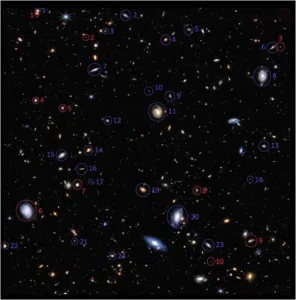A single researcher’s analysis of Webb Space Telescope images may suggest that we are all stuck in a black hole, according to a study published in the Monthly Notices of the Royal Astronomical Society.
“The main finding of the study is that the vast majority of galaxies in the universe, as seen from Earth, rotate in the same direction,” explained Lior Shamir, an astronomer at Kansas State University and lead author of the study, in an email to Gizmodo. “This adds another observation that is not consistent with the current cosmological model.”
The current cosmological model, called Lambda CDM (short for Cold Dark Matter), has been subjected to numerous stress tests over the years. One such test showed that the data from the decommissioned Planck satellite would be better explained if the universe were round.
“It is becoming increasingly clear that the Lambda CMB is at least incomplete,” Shamir added. “Perhaps the advantage of this observation is that anyone can see it very easily by simply looking at images of the early Universe.”
Shamir has studied 263 galaxies as part of the Webb Telescope’s Joint Advanced Deep Extragalactic Survey (JADES) program. He found that about two-thirds of the galaxies rotate clockwise, while only a third rotate in the opposite direction. Although the motion was detected quantitatively, Shamir said Webb’s sharp vision allowed him to visually determine the direction of rotation of each galaxy.

“I think we see more galaxies rotating in the opposite direction to the Milky Way because of the motion of these galaxies relative to the motion of the Milky Way,” Shamir said. “The motion makes them brighter, and that’s why we see more of them. But I could be wrong, and then there are more galaxies in the real Universe that rotate in the same direction.”
Shamir explained that black holes are born rotating, and perhaps as a result of this, there are more black holes rotating clockwise. This suggests that our universe may be inside a black hole.
We think of black holes as regions of space-time with such intense gravity that even light cannot escape beyond a certain limit known as the event horizon. Beyond this limit, the densely packed matter inside the black hole remains invisible – hence its name. But some theoretical black holes can be perceived as infinitely expanding for an observer inside them, while remaining static, of a finite size for an outside observer.
Thus, it is also possible that small universes exist inside our universe, beyond our perception and within the larger cosmos. Thus, our universe may simply be inside a black hole in some larger universe, which calls into question the very word “universe” and introduces the concept of a multiverse. The idea is not new, but the study of the rotation of galaxies provides further evidence that there is almost certainly more to the universe than we see in the form of light.
But there is another possibility for the uneven splitting of galactic rotation: The Milky Way’s own rotational speed affects the team’s measurements. More observations may clarify this discrepancy.
In the meantime, expect JADES to provide more information about deep space. In 2023, astronomers thought they may have spotted dark-matter-fueled stars in JADES images, and last year the project discovered the most distant galaxy ever seen (and one that was surprisingly bright). Suffice it to say, JADES will reveal many more mysteries before we have comprehensive answers.









